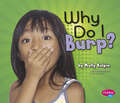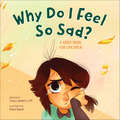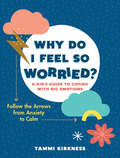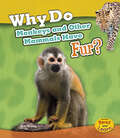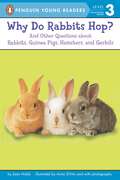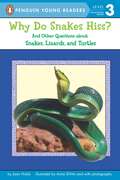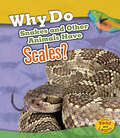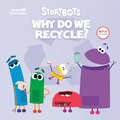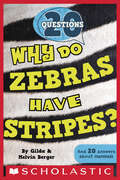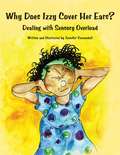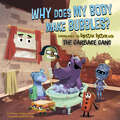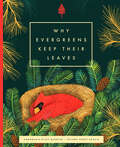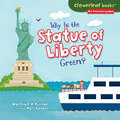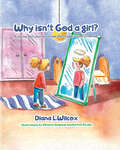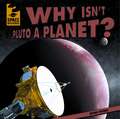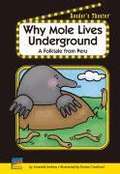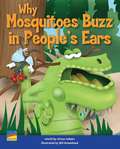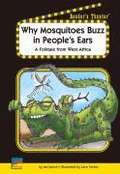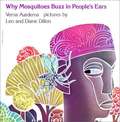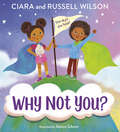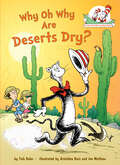- Table View
- List View
Why Do I Burp? (My Silly Body Ser.)
by Molly KolpinBurps can be loud and sometimes even stinky. Everyone burps—from babies, adults, and even some animals. Take a journey into the body, following air down the esophagus to the stomach and back up again. Simple, informative text and full-page photos and diagrams help early readers understand what makes us burp and why it’s important.
Why Do I Feel So Sad?: A Grief Book for Children
by Tracy LambertHelp kids start to heal after grief and loss—for ages 5 to 7Why Do I Feel So Sad? is an inclusive, age-appropriate, illustrated kid's book designed to help young children understand their own grief. The examples and beautiful illustrations are rooted in real life, exploring the truth of loss and change, while remaining comforting and hopeful.Broad enough to encompass many forms of grief, this book reassures kids that they are not alone in their feelings and even suggests simple things they can do to feel better, like drawing, dancing, and talking to friends and family.Why Do I Feel So Sad? is:Practical and compassionate—Written for early childhood-aged kids, this book touches on common sources of grief—everything from death to divorce or changing schools.Different for everyone—This book normalizes the confusing thoughts and physical symptoms that come with grief, so kids know there's no one right way to feel or heal.Tips for grownups—Find expert advice and simple strategies for supporting grieving kids in your life.Children don't have to go through grief alone; this book provides the tools to help them.
Why Do I Feel So Worried?: A Kid's Guide to Coping with Big Emotions—Follow the Arrows from Anxiety to Calm
by Tammi KirknessSimple yes-or-no questions help kids ages 7 to 12 find the right calming activities for every kind of anxiety It can be tough for kids with growing minds to work through their worries and self-soothe when they&’re spiraling. This interactive, step-by-step guide is here to help! In Why Do I Feel So Worried?, children can follow an easy-to-use, colorfully illustrated flowchart to . . . Name the emotion they&’re struggling with (like stress)Figure out its source (for instance, homework problems)Calm down with an easy activity (such as a soothing script) Every tried-and-tested strategy—from breathing techniques to meditations, affirmations, and more—offers in-the-moment relief to anxious children. And throughout, notes to caregivers explain the underlying psychology along with how (and when) to offer help. Kids might not always be able to solve what&’s worrying them—but they do have the power to help themselves feel better!
Why Do Leaves Change Color? (Let's-Read-and-Find-Out Science 2)
by Betsy MaestroRead and find out about the magical process of how leaves change their color in this colorfully illustrated nonfiction picture book.This book includes simple, fun diagrams that help introduce concepts like photosynthesis and the different types of leaves. This book also includes a list of the best spots to view leaves changing color as well as simple activities to do with leaves, like leaf rubbings and leaf pressings.Questions addressed in this book include:How do leaves feed trees?What kind of weather brings out the best colors?Why is winter a time of rest for trees?Read and find out in the proven winner Why Do Leaves Change Color?This is a Level 2 Let's-Read-and-Find-Out, which means the book explores more challenging concepts for children in the primary grades. The 100+ titles in this leading nonfiction series are:hands-on and visualacclaimed and trustedgreat for classroomsTop 10 reasons to love LRFOs:Entertain and educate at the same timeHave appealing, child-centered topicsDevelopmentally appropriate for emerging readersFocused; answering questions instead of using survey approachEmploy engaging picture book quality illustrationsUse simple charts and graphics to improve visual literacy skillsFeature hands-on activities to engage young scientistsMeet national science education standardsWritten/illustrated by award-winning authors/illustrators & vetted by an expert in the fieldOver 130 titles in print, meeting a wide range of kids' scientific interestsBooks in this series support the Common Core Learning Standards, Next Generation Science Standards, and the Science, Technology, Engineering, and Math (STEM) standards. Let's-Read-and-Find-Out is the winner of the American Association for the Advancement of Science/Subaru Science Books & Films Prize for Outstanding Science Series.
Why Do Monkeys and Other Mammals Have Fur? (Animal Body Coverings Ser.)
by Holly BeaumontFind out all about fur and how it helps monkeys keep warm and survive. Discover how fur can be used as camouflage, how fur is different on different mammals and how fur changes as mammals grow up.
Why Do Rabbits Hop?: And Other Questions About Rabbits, Guinea Pigs, Hamsters, And Gerbils (Penguin Young Readers, Level 3)
by Joan HolubWhy Do Rabbits Hop?And Other Questions about Rabbits, Guinea Pigs, Hamsters, and GerbilsDid you know that rabbits can jump 10 feet in one hop, guinea pigs bump noses to say hello, and baby gerbils are called pups?
Why Do Snakes Hiss?: And Other Questions About Snakes, Lizards, and Turtles (Penguin Young Readers, Level 3)
by Joan HolubMany people like snakes, lizards, and turtles, and there's so much to find out about all of these scaly-skinned animals. Are all snakes poisonous? Why do snakes shed their skin? What unusual things can lizards do? Do lizards ever lose their tails? Why do turtles have shells? Kids will find the answers—and much more—in this fun, fact-filled introduction to reptiles. Filled with colorful photographs and illustrations, this is just right for any reptile lover.
Why Do Snakes and Other Animals Have Scales? (Animal Body Coverings Ser.)
by Clare LewisFind out all about scales and how they help snakes and other animals move, stay safe and survive. Discover how scales are different on different animals and how they change as snakes and reptiles grow up.
Why Do We Recycle? (Pictureback(R))
by Scott EmmonsThe curious crew from Netflix's Ask the StoryBots star in an all-new storybook about recycling that includes over 30 stickers! Bing, Bo, and the rest of Netflix&’s StoryBots want to know where garbage goes. Join them on an adventure that takes them from the landfill to the recycling plant. Children ages 3 to 7 who love Ask the StoryBots will thrill to this fun and fascinating storybook that includes over 30 stickers. The stars of Netflix&’s Ask the StoryBots are curious little robots who bring a world of learning and fun to kids ages 2 to 7 across a broad range of subjects with their animated series. All of the award-winning StoryBots content is developed by teachers and early-education experts.
Why Do Zebras Have Stripes? (20 Questions Ser. #2)
by Melvin Berger Gilda BergerThe follow-up to the fun and informative 20 Questions #1: Why Do Feet Smell?A follow-up to 20 Questions: Why Do Feet Smell? (Spring 2012) featuring fun facts about animals. Why Do Zebras Have Stripes? will ask and answer the questions about animals that kids are really curious about. Each book in the 20 questions series contains 20 questions and answers, with a full-color photograph on every page. Read the question on the right and turn the page to see the answer on the left!
Why Does Izzy Cover Her Ears? Dealing With Sensory Overload
by Jennifer VeenendallAn illustrated book that creates an environment that is accepting of students with sensory modulation difficulties, including many on the autism spectrum. It includes definitions of sensory processing and sensory modulation disorder, suggested discussion questions, and lists of related books and websites.
Why Does My Body Make Bubbles?: Learning About The Digestive System With The Garbage Gang (The\garbage Gang's Super Science Questions Ser.)
by Thomas Kingsley TroupeGordy's taking a bath, when a stinky bubble floats to the surface. Gordy wonders, Why do bubbles come out of my body? When the bubble starts talking, it takes the gang on a journey through the digestive system that’s a total gas Too silly.
Why Don't You Get a Horse, Sam Adams?
by Jean FritzIn the early days of America when men wore ruffles, rode horseback, and obeyed the King, there lived a man in Boston who cared for none of these things. No one expected Samuel Adams to wear ruffles or pledge allegiance to the King of England, but his friends did think that he might get on a horse. But would he? Never! he said. An ALA Notable Children's Book.
Why Evergreens Keep Their Leaves
by Annemarie Riley GuertinIn the spirit of Oscar Wilde's The Happy Prince, Why Evergreens Keep Their Leaves is a timeless story of why the fir, spruce, and juniper trees are evergreen all winter long.
Why Frogs Are Wet
by Judy Hawes Mary Ann FraserFrogs can jump thirty times their own body length, catch insects on the wing, and breathe underwater or on land. But they must always keep their skins wet. Read and find out why!
Why Frogs Are Wet (Let's-Read-and-Find-Out Science 2)
by Judy HawesRead and find out about frogs in this colorfully illustrated nonfiction picture book.Frogs can jump thirty times their own body length, catch insects on the wing, and breathe underwater or on land. But they must always keep their skins wet. Read and find out why! This is a clear and appealing science book for early elementary age kids, both at home and in the classroom. It's a Level 2 Let's-Read-and-Find-Out, which means the book explores more challenging concepts for children in the primary grades. The 100+ titles in this leading nonfiction series are:hands-on and visualacclaimed and trustedgreat for classroomsTop 10 reasons to love LRFOs:Entertain and educate at the same timeHave appealing, child-centered topicsDevelopmentally appropriate for emerging readersFocused; answering questions instead of using survey approachEmploy engaging picture book quality illustrationsUse simple charts and graphics to improve visual literacy skillsFeature hands-on activities to engage young scientistsMeet national science education standardsWritten/illustrated by award-winning authors/illustrators & vetted by an expert in the fieldOver 130 titles in print, meeting a wide range of kids' scientific interestsBooks in this series support the Common Core Learning Standards, Next Generation Science Standards, and the Science, Technology, Engineering, and Math (STEM) standards. Let's-Read-and-Find-Out is the winner of the American Association for the Advancement of Science/Subaru Science Books & Films Prize for Outstanding Science Series.
Why Is the Statue of Liberty Green? (Cloverleaf Books (tm) -- Our American Symbols Ser.)
by Holli Conger Martha E. RustadDo you know that the Statue of Liberty hasn't always looked green? Or that the first torch had to be replaced? Lady Liberty has been an important US symbol for more than one hundred years. Join Mrs. Bolt's class as they visit the statue and learn where the statue came from, how she was built, and what American ideas she represents.
Why Isn't God a Girl: A Young Girl's Journey to See the Image of God in Herself
by Rev. Diana WilcoxSophy is told that she is made in the image of God, but the only God she has ever heard of is called Father. It doesn't make any sense, so she decides to find out why God isn't a girl. What she discovers changes everything! This beautifully illustrated picture book, by Reverend Diana Wilcox, an Episcopal priest, will captivate the imagination of every child with beautiful illustrations and a narrative that engages both parent and child. Sophy's journey explores themes of gender, interfaith understanding, and diversity in God's creation. The book also includes resources for all who work with and love children. The original edition of Why isn't God a Girl? won a Readers' Favorite Illustration Award winner and a Readers' Favorite Honorable Mention in the Children Religious Theme genre!"Mother Diana's passion for the Gospel and the inclusive message of Jesus has sparked her pastoral response to girls searching for their place in God's plan. Her book helps girls and boys to discover God's feminine image in which women are created. She places the characters of her book in the interfaith communities in which so many of us live and work. Parents, teachers, and members of the clergy will find in her phenomenal book a resource for helping people to discover the deep truth of God as our Mother in a simple lesson."--The Rev. Peter DeFranco
Why Isn't Pluto A Planet? (Space Mysteries Series)
by Michael PortmanFor many years, it was accepted as fact that our solar system had nine planets. <P><P>However, one important meeting of astronomers in 2006 reduced that number to eight. They decided that Pluto was not a planet, a declaration that outraged some people. <P><P>Readers will learn more about distant Pluto, such as how it was accidentally discovered. Brilliant photographs accompany the fascinating facts.
Why Mole Lives Underground: A Folktale from Peru
by Jeffrey Fuerst Amanda Jenkins Emma CrawfordPerform this folktale from Peru about how hard work makes dreams come true.
Why Mosquitoes Buzz in People's Ears
by Bill Greenhead Alison Adams Sera Y. ReycraftClassic Tales: Why Mosquitoes Buzz in People's Ears
Why Mosquitoes Buzz in People's Ears: A folktale From Africa
by Jeffrey Fuerst Ian James Lane YerkesPerform this folktale from Africa about a fast–talking mosquito. (Set of 12 with Teacher's Guide)
Why Mosquitoes Buzz in People’s Ears: A West African Tale
by Verna Aardema Leo Dillon Diane DillonNIMAC-sourced textbook
Why Not You?
by Ciara Russell WilsonFrom Grammy-winning pop star Ciara and Super Bowl champion quarterback Russell Wilson comes a picture book to inspire young readers to see the value in themselves, be brave, and go after their biggest dreams! Why not you? Amazing you! You&’re a winner! You&’re so strong! You are perfect and important—you and all your gifts belong! We all have big dreams! Sometimes it&’s hard to imagine our big dreams coming true. But what if someone saw all the amazing and spectacular parts of us—our winning smiles, our fancy feet, our warm hearts—and asked, &“Why not you?&” Whether it&’s becoming a football player or a pop star or the president or a scientist: Why not you? In this picture book debut, superstars Ciara and Russell Wilson encourage readers to see themselves achieving their dreams, no matter how outrageous they may seem. It&’s a lyrical celebration of self-esteem, perseverance, and daring to shoot for the stars.
Why Oh Why Are Deserts Dry? All About Deserts: All About Deserts (The Cat in the Hat's Learning Library)
by Tish RabeLaugh and learn with fun facts about desert animals, cacti, sand dunes, and more—all told in Dr. Seuss&’s beloved rhyming style and starring the Cat in the Hat! &“You may think that deserts are empty and bare, but you&’ll be surprised by the things we&’ll find there...&” The Cat in the Hat&’s Learning Library series combines beloved characters, engaging rhymes, and Seussian illustrations to introduce children to non-fiction topics from the real world! Journey through the deserts of the world and learn: how plants and animals have adapted to survive the unforgiving climatewhy deserts don&’t have to be hotwhat causes us to see miragesand much more! Perfect for story time and for the youngest readers, Why Oh Why Are Deserts Dry? All About Deserts also includes an index, glossary, and suggestions for further learning.Look for more books in the Cat in the Hat&’s Learning Library series!Cows Can Moo! Can You? All About FarmsHark! A Shark! All About SharksIf I Ran the Dog Show: All About DogsOh Say Can You Say Di-no-saur? All About DinosaursOn Beyond Bugs! All About InsectsOne Vote Two Votes I Vote You VoteThere&’s No Place Like Space: All About Our Solar SystemWho Hatches the Egg? All About EggsWish for a Fish: All About Sea Creatures
